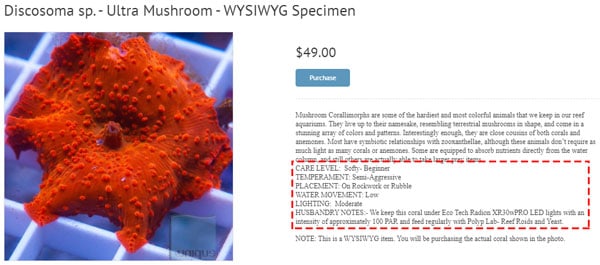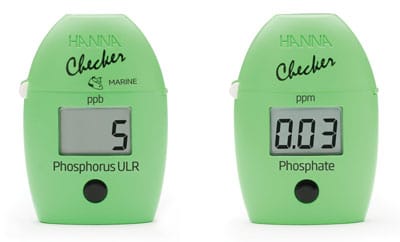I reached a point in my aquarium where I had placed my first corals and waited several months for them to settle in and start growing, but nothing. I mean squat. They hadn’t even grown a millimeter!
The corals were in good health, full of color, the polyps were open and they reacted to stimuli like the shrimp crawling all over them but no growth. I was baffled.
If corals in a reef tank are not growing, the aquarium may be lacking light in the correct wavelengths and power, flow may be too low to remove pollutants from their bodies, water parameters are not stable enough, or there may be pests irritating them.
This article is about what I researched and found was causing the problem with my aquarium. All the other great tips I found are also included too as every aquarium is different.
What Do Corals Need To Grow?
Corals are simple creatures and there are 4 main genres we deal with in our hobby:
- Soft Corals, commonly referred to as ‘Softies’. Great beginner corals!
- Large Polyp Stony Corals, commonly referred to as LPS. Great beginner to intermediate corals.
- Small Polyp Stony Corals, commonly referred to as SPS. Experience required and very stable parameters.
- Non-Photosynthetic Corals, commonly referred to as NPS. Expert only and require constant attention and feeding.
This article is going to focus mainly on softies and LPS as those are the main beginner corals and if you cannot get these corals to grow, then SPS will most likely not survive if added at this stage.
To allow corals to grow there are three requirements we need to ensure are met before we delve deeper into other causes:
- Light
- Flow
- Water Stability
Light
All of the corals above, except the NPS corals get 95% of their energy from light. Their tissue contains a plant-based organism called Zooxanthellae that creates energy from light by photosynthesis.
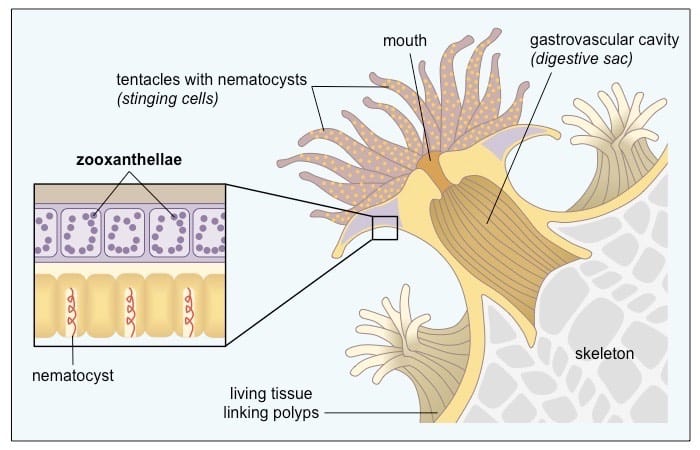
Because the Zooxanthellae are what creates the majority of the coral’s energy, we need to ensure the light we give them is designed to maximize their energy-production.
Zooxanthellae is divided up into different groups or ‘Clades’. These Clades respond to different wavelengths of light and there are three Clades as hobbyists we need to target. Clades A, B, & C.
Each of these Clades works in a different part of the light spectrum and any light fixture you purchase will need to target these wavelengths for your coral to grow. Clade A is the most prominent group of Zooxanthelle to provide coral growth.

The three areas above are where the different Clades work most efficiently. Ensuring your light fixture has peaks to match the areas required by the coral’s zooxanthellae is the first step to ensuring your coral will grow. You can do this by looking at the manufacturer’s data, or by the wavelengths of each type of diode fitted to an LED cluster, or the wavelengths of the bulb/s of T5 or MH fixtures.
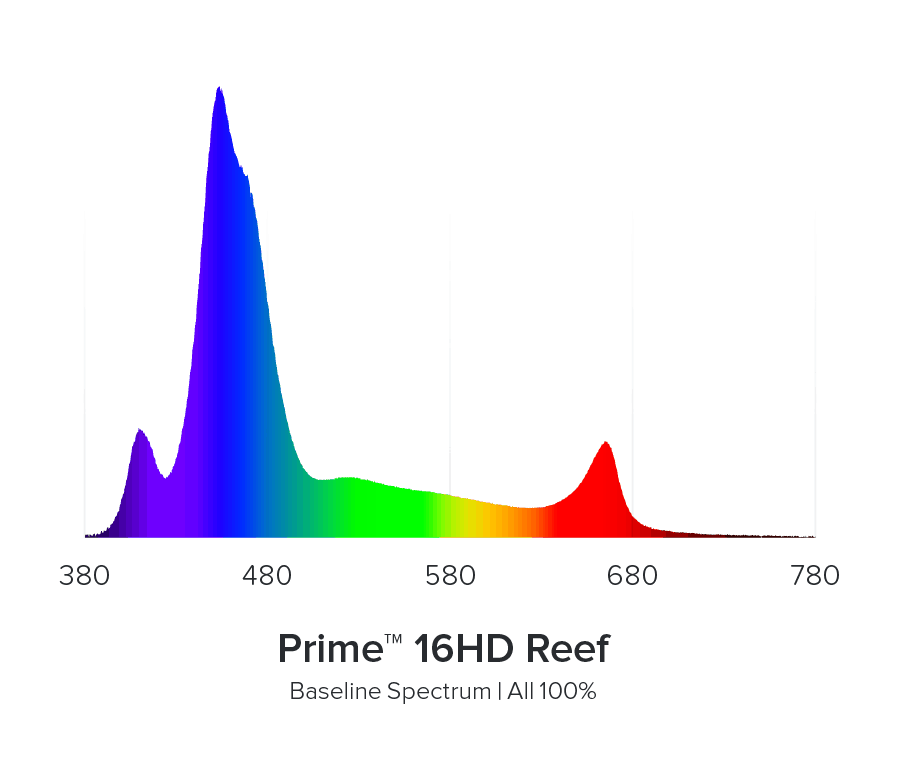
The next part of the lighting puzzle is to ensure they receive enough quantity of those wavelengths. This is the measurement of PAR.
As light penetrates through the water is becomes dissipated. The deeper and wider you go from the light source, the less light quantity the coral will receive.
Most reputable lighting manufacturers will give a PAR example diagram to help demonstrate PAR level from their fixtures in different areas of an aquarium.
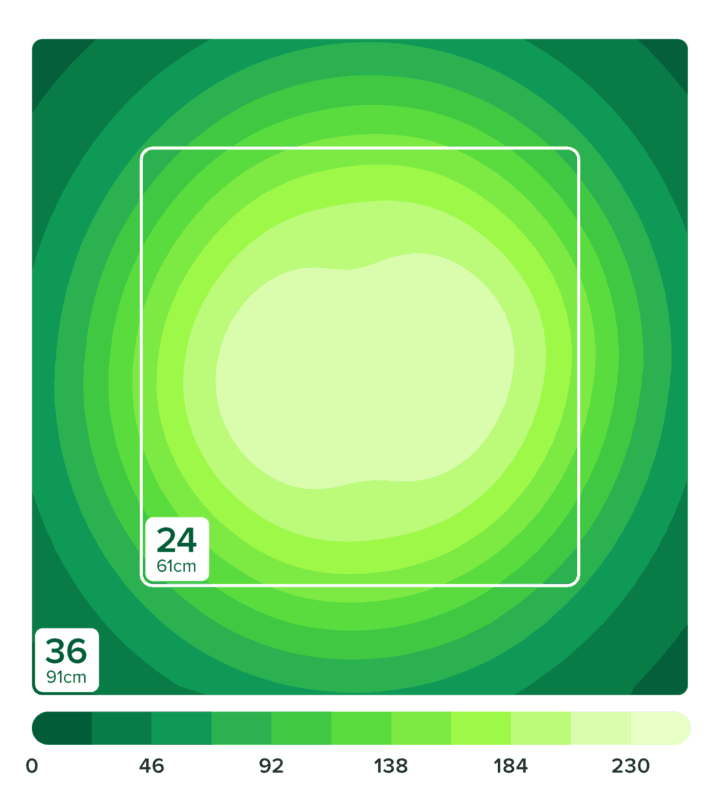
Knowing the PAR delivery capabilities of your light fixture will help you to find the right location for your coral. Placing a light-loving coral higher up the rockwork will ensure it receives more PAR. Low light corals like mushrooms will do well closer to the sand bed.
Below is a table of average PAR requirements for most corals species:
| Coral Species | PAR Range | |
| Low-Level Light | Soft Corals, Zoanthids, Mushrooms | 50-100 |
| Medium-Level Light | LPS Coral, Clams, Low-Light SPS | 100-200 |
| High-Level Light | SPS Coral, Clams | 200-500 |
To help ensure you have the correct lighting for your coral and to help find the best placement for each coral you can rent a Full Spectrum PAR Meter for a reasonable price Here at Aquariumspecialty.com
After good lighting, the next requirement to allow your corals to grow is flow.
Flow
Most aquarists know you need a lot of flow for corals but many underestimate just how crucial flow is to the long-term health of your coral.
For a coral, the flow of water around it helps to do several things:
- It brings them food which they can capture and bring to the polyp mouth
- It aids in the removal of organic waste from the tissues as they metabolize
- It aids in gas exchange in the tissue cells. Removing CO₂ and absorbing O₂
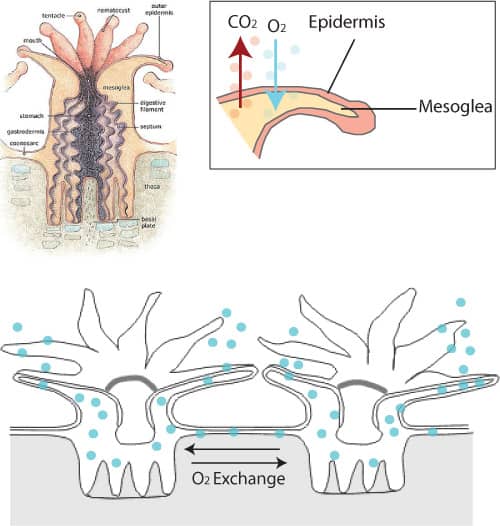
Many aquarists talk about “You need X gallons per minute” for certain types of coral and although in many aspects they are correct to a point, but what is really the case is providing the right amount of random, alternating flow to match the coral in your aquarium.
Having lots of flow in one direction does not always suit the coral. As the corals have tissue on all sides it is important to ensure that all sides of the coral receive the right volume of flow. Random flow is how this is done.
When a coral is in a location where it is receiving a constant flow of water from one direction this can lead to it keeping its polyps closed and sometimes tissue erosion. This will almost always end in the death of the coral. Corals prefer to have flow around them rather than directly at them.
This can be achieved by aiming powerheads in front of them or over them so the venturi effect of the passing water flow will move the water indirectly around the coral.
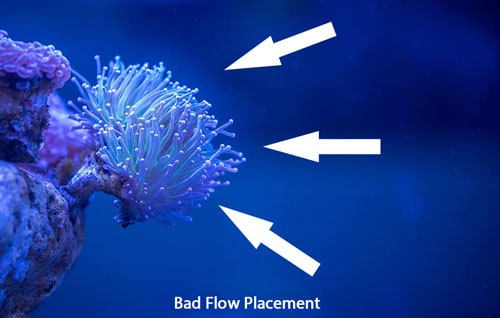
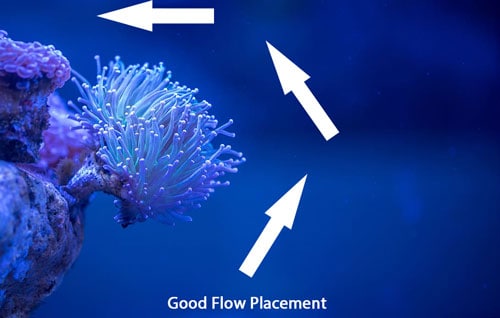
With the evolution of DC controllable pumps within the last decade or so it is now even easier to generate powerful, random flow patterns that provide the optimum environment for your coral. By linking multiple pump heads together to work them as a team, following a set flow pattern you will see an instant improvement in coral health and vitality.
When purchasing or researching your next coral, knowing the kind of habitat it thrives in is paramount. One of the best places to find out this information is an online coral retailer like UniqueCorals.com.
All of their coral listings come with a super-easy details section listing all the important parameters for the individual coral:
To help find the correct flow for coral follow this generalization:
Soft Corals – Low Flow – Around 10x aquarium volume
LPS Corals – Low to Medium Flow – Around 10x-15x aquarium volume
SPS Corals – High to Very High Flow – Around 20x-100X aquarium volume
For example:
30 gallon aquarium
10x flow = 30×10 = 300 gallons per hour flow rate from pumps
75 gallon aquarium
15x flow = 75×15 = 1125 gallons per hour flow rate from pumps
Having more than this flow rate in your aquarium is totally acceptable and generally very easy to accomplish with today’s powerful powerheads and wavemakers. By careful placement of your coral, you can find the lower flow areas for soft and LPS coral.
By directing the flow of your pumps around the water surface then placement of coral lower in the aquarium will allow for good, indirect random flow,
Stability
Stability in your water parameters is what will give your corals the best growth but the only way you can ensure your water parameters are stable is by regular, consistent testing.
When a parameter like alkalinity is high, low, high, low your coral is going to be in a constant state of catch up. Think of it like trying to catch the ice-cream truck when you were a kid, and every time you almost get to the window they drive off to the next stop! You spend more energy chasing than eating. Your coral is the same.
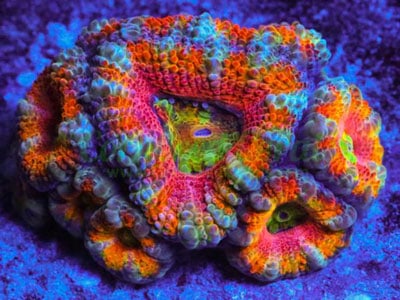
To ensure stability you need to be testing correctly and regularly. This is done with the following rules:
- Use only quality test kits that are in date or testing instruments that are regularly calibrated.
- Testing at the same time each day or week depending on what you are aiming to achieve. I test my water every Tuesday evening. By testing the same time, every time, you get the aquarium in the same part of its daily cycle.
- Keep a note of all parameters for the last few months. This will allow you to spot any trends.
- If you have an odd test result, test again. If it is still odd, try another test kit.
- Never test your water while drinking alcohol. Many a tank has been crashed due to supplementing based on a misread test result.
- Your tank will find its own balance in its parameters but aim to be in the following ranges:
- Temperature: 78 – 80°F or 25 – 27°C
- Specific Gravity (Salinity): 1.023 – 1.025
- Ph: 8.1 – 8.4
- Ammonia: 0ppm
- Nitrite: 0ppm
- Nitrate: <5ppm
- Alkalinity: 8 – 12 dkh
- Calcium: 350 – 450ppm
- Magnesium: 1250 – 1350ppm
- Phosphate: <0.03ppm for SPS Corals
- Phosphate: <0.05ppm for LPS, Zoas & Soft Corals
- Phosphate: <0.2ppm for Fish Only
Now you are aware of the 3 major factors that a coral needs to grow and you have ensured that your setup is meeting these, if your coral is still not growing then we need to look at other factors that can be causing your coral to seem dormant.
Is Only One Coral Not Growing or All Corals?
When aquarists come onto many of the forums seeking help and advice for their corals not growing I always ask them if it is just one coral that is not growing or is it one type of coral (LPS, SPS, etc) or is it that all the corals are not growing.
This way we can break it down into 3 areas:
- One Coral
- One Type of Coral
- All Coral
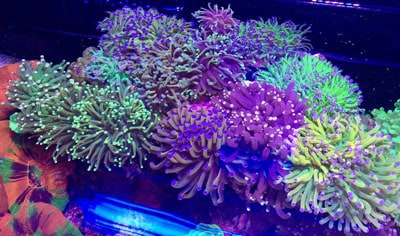
One Coral
When it’s only one coral that does not appear to be growing these are the things you can check first:
- Is it a really slow-growing species of coral? Some of the popular LPS corals like Fungia, Scolymia, and Lobophyllia can be notoriously slow growers and may appear even slower especially if they are around fast-growing corals
- Is the coral under attack by a pest? Some wrasses and pygmy angels are known to pick at some corals. Maybe set up a webcam and record the coral for a few days, then fast-forward through the footage to see if you can find a culprit.
Have you found any bugs hiding out in or under the coral? - Some crabs are known to attack corals, especially at night. Using a red flashlight after the lights are out is great for spotting predators you may never knew you had. The red light is unseen by most animals in the aquarium and allows you to hunt the hunter!
- Diseases like Brown Jelly Disease and Tissue Necrosis can start in a small area and soon spread. Use online photos off Google to try and narrow down any signs of tissue loss to help determine what disease it may be.
- Have you placed the coral too near to a neighbor that is stinging it during the night? Some corals can release sweeper tentacles over 8″ and cause distress to anything it touches. Look at night to see if you can see this. Area of the coral where there are no polyp extension or white patches could indicate areas being stung.
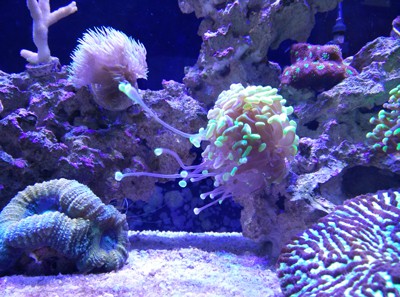
One Type Of Coral
Do you have a particular type of coral that doesn’t seem to grow no matter what you try? Many people are unable to keep Zoanthids or GSP alive, yet everything else flourishes.
To fix this, research as many different sources for care requirements of the coral and see if you need to test for a different parameter.
Using the coral listings mentioned above at UniqueCorals.com is a good starting point for finding the corals’ basic needs.
Google your plight as there have been many before you with the same problem but could also have solutions. “Unable To Grow Zoanthids” in Google Search just brought up 3 top forums with the same questions.
Unfortunately, listing every possible problem with a solution in this article would keep you reading until the next millennia!
All Corals
If you are having no growth with ALL of your coral then you need to look at your aquarium setup. The big 3 first mentioned above are your first areas to address, but after those, I suggest you start working through the list below.
What Are Possible Causes Of No Coral Growth In Aquariums?
Old Bulbs – Metal Halide and T5 bulbs begin to lose their power and color spectrum after 6-12 months. Because of this most manufacturers recommend replacement every 8 months to ensure your coral is receiving the optimum levels of light for growth.
High Phosphates – Do you have high phosphate levels in your water? Are you even using the correct testing device? The only good recommended testers are the Phosphate and Phosphorous Checkers from Hanna.
You can find out more information on the Hanna Checkers HERE at Amazon.com
Most test kits are unable to test low enough to register phosphate levels and you may think your aquarium is at zero, when in fact you could be at 0.1ppm. You need to be under 0.05ppm for LPS and Softies and under 0.03ppm for SPS.
Phosphate inhibits Calcium intake in coral thus preventing them from growing their skeleton. LPS corals like Frogspawn, Fungia, Candy Cane, and Torches all comprise of a Calcium skeleton from which they grow.
Water Too Clean – As silly as it sounds, your water can be too clean! Your corals still need a very small amount of Nitrate (<5ppm) and a trace amount of Phosphate to allow your coral to grow.
The Zooxanthellae in the coral tissue is a plant-based organism and it needs these nutrients to grow, but too much will inhibit its growth. It’s that fine line you need to aim for.
Running Granular Ferric Oxide (GFO) or Biopellets when they are not required can instantly make your water too clean.
Unless you are purposely running a ULNS (Ultra Lown Nutrient System) aquarium for growing SPS coral, you need to have a tiny bit of the required nutrients.
Usually, getting your water too clean is not a problem for most hobbyists. Having too high a nitrate or Phosphate problem is the norm.
Insufficient Filtration/Detritus Removal – The opposite problem to ULNS is having to much Nitrate and Phosphate. Feeding too heavy, overstocked, undersized skimmer, collecting detritus, flow dead spots, infrequent water changes all can lead to high Nitrate levels which will cause you problems.
Keeping your Nitrates under 5ppm will ensure you have nice coral growth and color. Properly sized equipment and a good regular maintenance schedule will be the best start you can ever have to good coral growth.
Download your Free Maintenance Schedule Right Here:
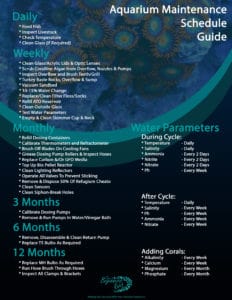
Pour Source Water – Having good quality water to begin with is a fundamental for any aquarist. Water from the city or your well could be laced with numerous heavy metals, silicates, nitrates, phosphates and a ton of other pollutants.
By stripping these from your water with a good quality RO/DI water filtration unit you will be well on your way to a healthier reef!
Lighting Period – Although very rare, I have found this one caused an entire tank full of coral to never grow because the owner split his lighting period. He had lights on in the morning while getting ready for work, then off during the day, then turn back on for the evening when he got home.
Corals are a living organism that relies on the natural cycle of the sun, or simulated sun in our case to control their metabolism. When that cycle is interrupted it affects the coral’s ability to produce energy, thus preventing its growth.
Set your lights to match a proven schedule. A simple Google search for your type of light will easily find you many schedules.
For Example:
Google ‘Kessil A360 Lighting Schedule’
Browning/Bleaching – Has your coral begun to turn brown or white? Have you changed your lights recently? Upgraded perhaps?
Bleaching is when your corals begin to turn white because they are receiving too much light. This is the Zooxanthellae protecting the coral’s tissue. Reduce the light intensity or ON Time to let the corals acclimatize and then slowly increase the intensity or ON Time over a few weeks to your desired setting.
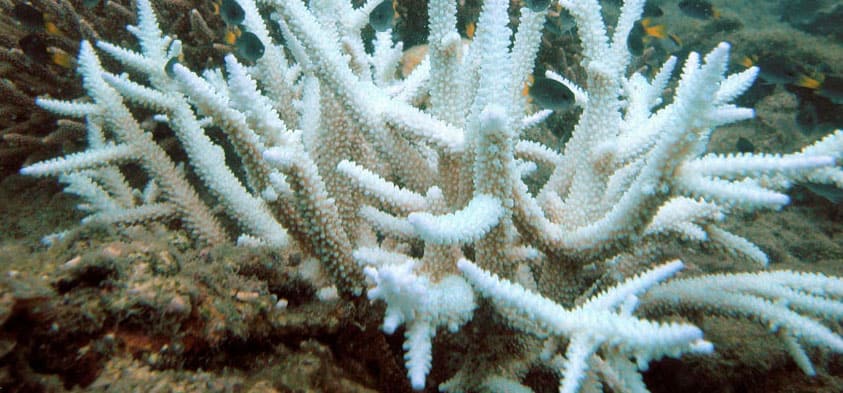
Browning of coral is usually the opposite of bleaching, where the coral is not receiving enough light or the light fixture you have is not of a high enough quality to keep the corals you require.
Some simple first steps to try are to increase the intensity of the light if able, lower the light closer to the water, install a second light to double the lighting output or run the lights for a longer photoperiod during the day.
If none of these work after a few weeks, then you may need to upgrade to a higher quality light. Fish do not need light to survive, but coral do, and if this is your first dive into keeping coral then a better light will most likely be required.
For more information on coral capable reef lights see the link at the bottom of this article.
How Can You Get Faster Coral Growth In An Aquarium?
So now you have some ideas on what may be causing your slow coral growth and have hopefully got them growing again, there are a few things you can do to really increase the growth rate:
Fish Poop – As stupid as it sounds, fish poop is one of the best coral foods you can get. Having fat and happy fish is the best thing you can do, but ensure all the uneaten food is removed to prevent a nutrient problem.
Supplemental Feeding – If your fish poop delivery is at its maximum there are a number of really good coral foods you can purchase to feed your corals. Purposely designed foods can really help to enhance the growth, color, and vitality of your corals.
For a great selection of highly praised coral foods check them out Here at Amazon.com
Upgrades – Lighting and flow are two of the best upgrades you can do to help your aquarium grow incredible coral. One of the best recommendations I have is to find an aquarium that is how you would love yours to look and try and copy their equipment list, lighting period and maintenance schedule. You know it works for them so it should work for you.
Maintenance – At the start of this article I spoke about water parameter stability and this is all achieved by regular water testing and regular maintenance. Having your water parameters matching the recommended parameters above and keeping them stable week after week is by far the greatest way to grow coral.
To Finish
Having no coral growth can always be traced back to either a single problem or a culmination of problems. By following through some of the suggestions in this article I hope you are now on a path to a beautiful aquarium full and incredible coral.

